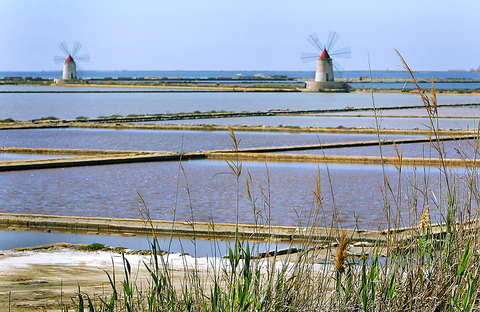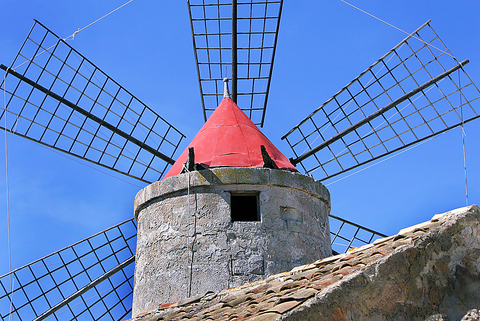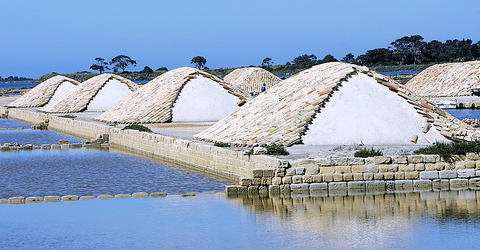Thousands of years ago, before Sicily became famous as the birthplace of the Mafia; before it retired the prize for the world's perfect oranges; before it was conquered by the Italians, or the Saracens, or even ancient Rome, this sprawling Mediterranean island was fiercely prized for its rich annual haul of salt.
When no one could imagine such a thing as a refrigerator, salt was by far the best way to preserve food. It was shipped across the sea, used as money, mixed into paste, and sculpted into jewelry.
Sicilians along the island's smooth western shore, blessed with saline water and hot windy summers, found themselves sitting on an almost priceless resource. They refined the technique of raking salt out of evaporated seawater, transforming the coast into a vast salt factory dotted with ponds, sluices, and nearly priceless white mounds.

PHOTOS: NY TIMES NEWS SERVICE
Two thousand years later, salt costs a US dollar a can in every supermarket in the world, and Sicily's biggest export for the past half-century has been its people. Modernity has created deep contradictions here: Tourists flock to extraordinary Greek ruins and the terraced four-star hotels of the east coast. There's a ski resort on volcanic, 3,352m Mount Etna. Behind that facade, the island remains a network of farms and poor villages struggling to lift itself from its corrupt feudal past.
But I had also heard that on the remote west coast there were still wide, shallow pools of seawater, and still a handful of people who spent Sicily's excruciating summer months raking evaporated slush into mounds of white crystals. It sounded so pointless, so labor-intensive, so Italian. Of course, I had to see it.
We were going to Sicily in any event. My wife studies ancient art, and we had mapped out a two-week trip around the island to see the remnants of Greek and Roman rule. The salt would require a modest little detour to the coastal city of Trapani, the unofficial capital of the salt industry.

It was March, well before the tourist season. To the east, resort hotels were just starting to unfurl their awnings. In the mountainous heart of the island, stiff winds were kicking up squalls of snow. Airport posters always make Sicily look like the Costa Brava, a playland of golden vineyards and beach umbrellas, but not this time of year. I stuffed my bathing suit into the bottom of my suitcase and bought a pair of thick felt pants.
We rented a white Fiat with a trunk that barely closed over our bags and headed west, away from the capital Palermo and the big resorts. I had been warned about the terrors of driving in Sicily, but we floated almost calmly across its broad ribbon highways, cutting through green hills speckled with the island's ubiquitous half-built concrete apartments. We laughed about our car's tiny engine and its tiny name — Punto, the Dot — until we started noticing other Fiat Puntos passing us at 193km an hour, straight into oncoming traffic. Far sooner than we expected, maybe an hour from the airport, we found ourselves approaching the salt coast.
The remnants of the salt industry may not be among the great tourist pilgrimages of the Mediterranean, but we didn't have much trouble tracking them down. Road signs marked out the Via del Sale, or Salt Road, which runs south from Trapani to the next coastal city, Marsala.

We followed it out of town and the road opened up to a series of flat coastal farms. As we approached the shore, the farms gave way to something strange: huge rectangular fields of water. The interconnected shallow pools line the coast for kilometers, sprinkled with windmills only recently supplanted by newer ways to pump water and grind salt crystals.
Our destination was the obvious one: the Museo delle Saline. The museum doesn't have an address, so we followed signs through a townlet called Nubia and hoped. At the edge of an aquatic nature reserve, under a flat sunny haze and a stiff wind, we turned into a parking lot with a single low stone building.
The museum has a restaurant for seasonal visitors and a gift shop, but when we got there the restaurant was closed. In fact, the entire parking lot stood empty except for one car that was stationed, strangely, right across the front entrance. As we approached, the car door opened and a woman got out. "Museo?" we asked her. She was the curator. We were the only visitors.
The salt museum isn't big, but like many specialized museums it conveys a kind of dusty intensity about its subject. I had assumed salt would be a pretty idiot-proof crop: You let a bunch of seawater evaporate in the sun, and when it's crunchy and white, you're done. Not quite. If it evaporates too fast or too slowly, other substances — bad substances — crystallize out of the seawater and you end up with bitter salt, or metallic salt, and some Phoenician or Aragonese prince tortures you until you get it right. Saltmaking turns out to be an art: The seawater flows into a giant lagoon, and then is pumped into a hierarchy of evaporating pools, each with its own depth, temperature, and name.
The museum's walls were covered with complex diagrams and tables of salinity, as if to say: We know you thought this was easy. Massive wooden wheels and Archimedes' screws evoked decades of backbreaking labor. The salt flats had a human hierarchy, too, in which the water was carefully tasted and monitored by a curatolo, whose father had taught him how to tell when the salt was ready. Everything in the museum — the walls, the charts, the equipment — seemed covered with a fine white dust. I rubbed my finger on the dust and licked it. Salty.
Sicilian salt has a reputation for tasting like minerals and being quick-dissolving; its proponents cite its high magnesium content as a culinary virtue. I could never tell the difference. For me, the crunch and spark of salt in Sicily was like drinking a glass of wine in a vineyard: Somehow the stuff just tastes better if you're standing on the slice of earth that produced it.
As it turned out, we were there at the wrong time to see any saltmaking. Harvest season wouldn't begin until midsummer, when wet salt floats to the surface of the last pools like a crown of heavy spring snow. Seasonal workers rake the slush off, shape it into long pyramidal mounds, and cover the mounds with roofing tiles. All we could see here was the remainder of last year's harvest. Under their red tile covers, the piles of salt looked like peaked roofs with no houses below, a subdivision built from a condiment.
We made our way down the coast, following the salt road. We passed fields, fences, low farmhouses; one dead end took us to a windmill. Another turn took us to the ferry dock for the privately-owned island of San Pantaleo and another sort of salt museum: a working salt mill called the Saline Ettore e Infersa.
The coast was warm, quiet, sleepy. Nearby, an old man sold fake Phoenician antiquities out of his car. A cafe sold espresso and juice hand-pressed from Sicilian mandarin oranges. Vines trailed in the sun. Again, there was almost no one there but us.
Today, Sicily runs on almost everything except salt. That night we stayed at a converted farmhouse called the Duca di Castelmonte. Our host's last name, Curatolo, spoke of a family history at the top of the salt hierarchy, but he made his living from a farm, an inn, an olive oil business, and a soccer club. He also possessed a resource now more greatly prized than salt: the best cook anywhere for kilometers.
The point of salt, of course, is to put it on food. I'm not saying it was the salt, but our first dinner at the Curatolo farmhouse was like nothing you could imagine, one dish after another made with local ingredients, flavored with local olive oil. A clear cauliflower soup; a warm eggplant caponata; pounded steak seared in oil. Dinner ended with an unusual local liqueur made from fennel.
We would spend another 10 days in Sicily, visiting the famous parts and eating spectacularly well — unusual almond pesto, cheese grilled on an open fire, calamari hauled straight from the sea. We rarely saw any salt. At Italian tables, the presumption is that the chef does it right the first time. When we did ask for salt, we looked at it carefully. It rose in telltale clumpy mounds, the mark of sea salt still holding a bit of the moisture of the ancient salt pans. When we put it on our tongues, it tasted ... well, it tasted pretty much like salt.

This is the year that the demographic crisis will begin to impact people’s lives. This will create pressures on treatment and hiring of foreigners. Regardless of whatever technological breakthroughs happen, the real value will come from digesting and productively applying existing technologies in new and creative ways. INTRODUCING BASIC SERVICES BREAKDOWNS At some point soon, we will begin to witness a breakdown in basic services. Initially, it will be limited and sporadic, but the frequency and newsworthiness of the incidents will only continue to accelerate dramatically in the coming years. Here in central Taiwan, many basic services are severely understaffed, and

Jan. 5 to Jan. 11 Of the more than 3,000km of sugar railway that once criss-crossed central and southern Taiwan, just 16.1km remain in operation today. By the time Dafydd Fell began photographing the network in earnest in 1994, it was already well past its heyday. The system had been significantly cut back, leaving behind abandoned stations, rusting rolling stock and crumbling facilities. This reduction continued during the five years of his documentation, adding urgency to his task. As passenger services had already ceased by then, Fell had to wait for the sugarcane harvest season each year, which typically ran from

It is a soulful folk song, filled with feeling and history: A love-stricken young man tells God about his hopes and dreams of happiness. Generations of Uighurs, the Turkic ethnic minority in China’s Xinjiang region, have played it at parties and weddings. But today, if they download it, play it or share it online, they risk ending up in prison. Besh pede, a popular Uighur folk ballad, is among dozens of Uighur-language songs that have been deemed “problematic” by Xinjiang authorities, according to a recording of a meeting held by police and other local officials in the historic city of Kashgar in

It’s a good thing that 2025 is over. Yes, I fully expect we will look back on the year with nostalgia, once we have experienced this year and 2027. Traditionally at New Years much discourse is devoted to discussing what happened the previous year. Let’s have a look at what didn’t happen. Many bad things did not happen. The People’s Republic of China (PRC) did not attack Taiwan. We didn’t have a massive, destructive earthquake or drought. We didn’t have a major human pandemic. No widespread unemployment or other destructive social events. Nothing serious was done about Taiwan’s swelling birth rate catastrophe.